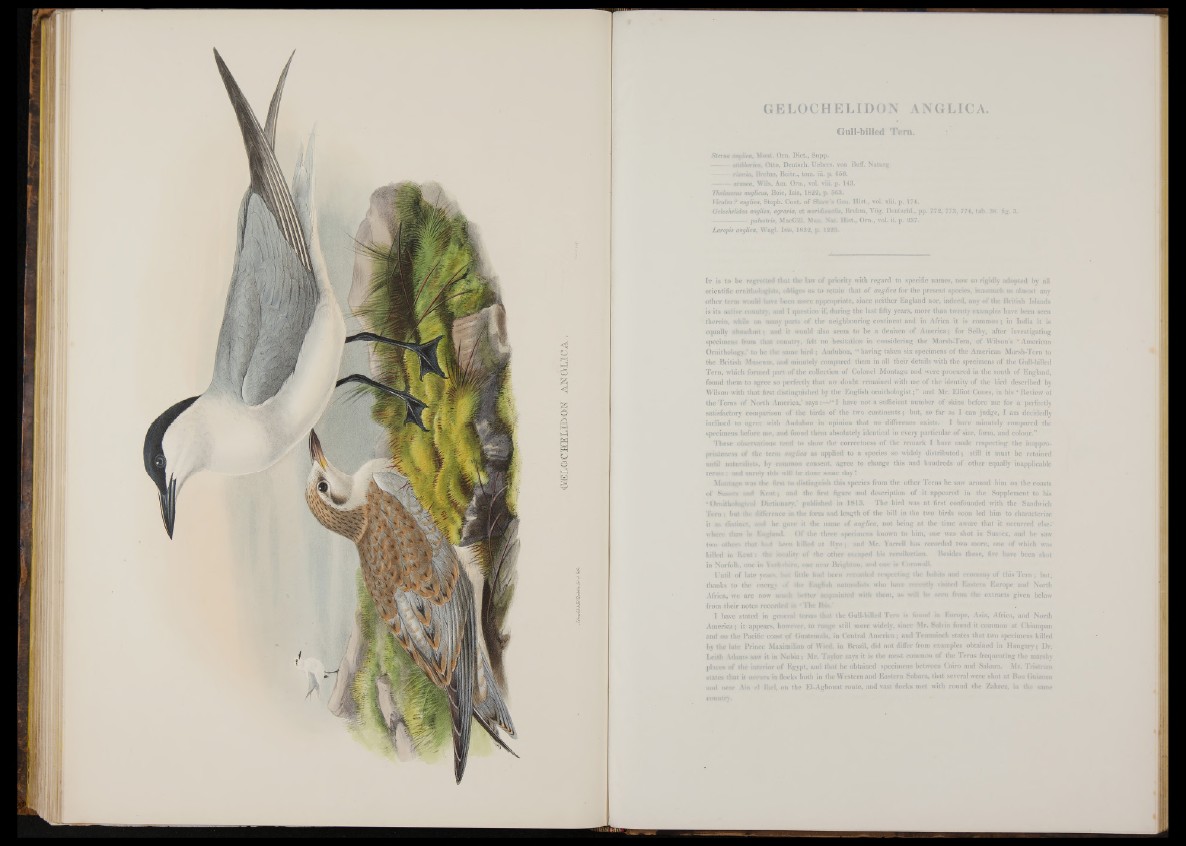
QELQCJCEllDON ANGLICA
Gull-billed Tern.
Sterna anglica, Mont. Ora. Diet., Supp.
siiibberica, Otto, Deutsch. Uebers. von Buff. Naturg.
risoria, Brehm, Beitr., tom. in. p. 650.
aranea, Wils. Am. Ora., vol. viii. p. 143.
Thalatsmt anglicus, Boie, Isis, 1822, p. 563.
Vtraloa ? anglica, Steph. Cont. of Shaw's Gen. Hist., vol. xiii. p. 174.
Gelochelidon anglica, agraria, et meridumaUs, Brehm, Vog. Deutschl., pp. 772, 773, 774, tab. 38. fig. 3.
--------------palustris, MacGill. Man. Nat. Hist., Ora., vol. ii. p. 237.
Laropis anglica, W ag l. Isis, 1832, p. 1225.
It is to be regretted tliat the law o f priority with regard to specific names, now so rigidly adopted by all
scientific ornithologists, obliges us to retain that o f anglica for the present species, inasmuch as almost any
other term would have been more appropriate, since peither England nor, indeed, any o f the British Islands
is its native country, and I question if, during the last fifty years, more than twenty examples have been seen
therein, while on many parts o f the neighbouring continent and in Africa it is common; in India it is
equally abundant; and it would also seem to be a denizen o f America; for Selby, after investigating
specimens from that country, felt no hesitation in considering the Marsh-Tem, o f Wilson’s ‘ American
Ornithology.' to be the same bird ; Audubon, “ having taken six specimens of the Americau Marsh-Tem to
the British Museum, and minutely compared them in all their details with the specimens o f the Gull-hilled
Tern, which formed part of the collection o f Colonel Montagu and were procured in the south o f England,
found them to agree so perfectly that no doubt remained with me o f the identity of the bird described by
Wilson with that first distinguished by the English ornithologist;” and Mr. Elliot Copes, in his ‘ Review of
the Terns o f North America,’ says:— “ I have not a sufficient number o f skins before me for a perfectly
satisfactory comparison o f the birds o f the two continents; but, so far as I can judge, I am decidedly
inclined to agree with Audubon in opinion that no difference exists. I have minutely compared the
specimens before me, and found them absolutely identical in every particular of size, form, and colour.”
These observations tend to show the correctness o f the remark I have made respecting the inappropriateness
o f the term anglica as applied to a species so widely distributed; still it must be retained
until naturalists, by common consent, agree to change this and hundreds of other equally inapplicable
terms : and surely this will be done some day !
Montagu was the first to distinguish this species from the other Terns he saw around him on the coasts
o f Sussex and Kent; and the first figure and description o f it appeared in the Supplement to his
* Ornithological Dictionary.' published in 1813. The bird was at first confounded with the Sandwich
Tern ; hut the difference in the form and length o f the bill in the two birds soon led him to characterize
it as distinct, .<■>;! he gave it the name o f anglica, not being at the time aware that it occurred else-'
where than in England. Of the three specimens known to him, one was shot in Sussex, and he saw
two others that fcsd been killed at R y e ;. and Mr. Yarrell has recorded two more, one o f which was
killed in Kent: the locality o f the other escaped his recollection. Besides these, five have been shot
in Norfolk, one in Yorkshire, one »ear Brighton, and one in Cornwall.
Until o f late years hwt little had been recorded respecting the habits and economy of this Tern ; but,
thanks to the energy <4 ¡he English naturalists who have recently visited Eastern Europe and North
Africa, we are now ranch better acquainted with them, as wvtt be seen from the extracts given below
from their notes recorded in ‘ The Ibri.’
I have stated in general terms that the Gull-hilled Tern is found in Europe, Asia, Africa, and North
America; it appears, however, to rtwge still more widely, since Mr. Salvin found it common at Cliiampan
and on the Pacific coast o f Guatemala, in Central America; and Temminck states that two specimens killed
by the late Prince Maximilian o f Wied, in Brazil, did not differ from examples obtained in Hungary; Dr.
Leith Adams saw it in Nubia; Mr. Taylor says it is the most common of the Terns frequenting the marshy
places o f the interior o f Egypt, and that he obtained specimens between Cairo and Sakara. Mr. Tristram
states that it occurs in flocks both in the Western and Eastern Sahara, that several were shot at Bon Guizoun
and near Ain el Ihel, on the El-Aghouat route, and vast flocks met with round the Zahrez, in tin* same
country.